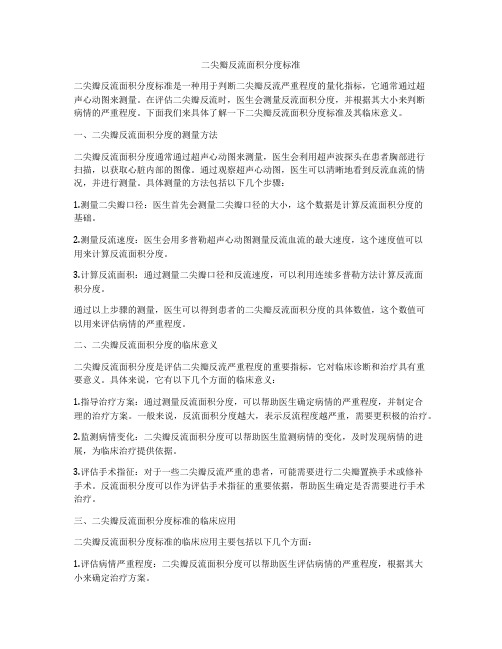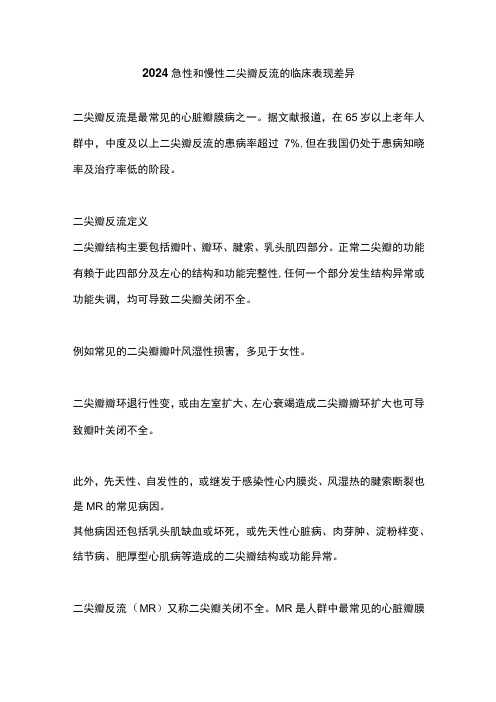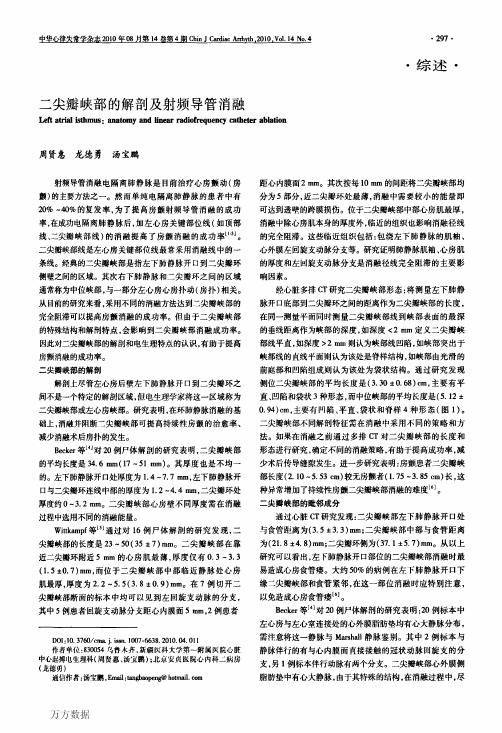二尖瓣反流示意图
二尖瓣三尖瓣轻度反流是什么意思?该怎么办?

二尖瓣三尖瓣轻度反流是什么意思?该怎么办?看了你的问题,我觉得你应该是偶有心慌,胸闷,去医院就诊,大夫给你做了一系列的检查,其他的都没有问题,唯有这个彩超显示:二尖瓣、三尖瓣轻度返流。
并且很可能大夫给你来了句:“没有大问题,继续观察”,之后因就诊时间问题,你一脸懵的回来了。
心想着“我有明明有心慌、胸闷,心脏彩超显示有问题,大夫又说没问题?到底是怎么个情况?”今天我就以你的角度从以下几个方面解答你内心的疑问,“二尖瓣、三尖瓣轻度返流是什么意思?怎么造成的?要不要紧?该怎么办?”“心慌可能是什么原因造成的?是应做哪些检查?需要排除什么疾病?”一、二尖瓣、三尖瓣轻度返流是什么意思?怎么造成的?要不要紧?该怎么办?大家看一下面这个图片,记住二尖瓣三尖瓣的位置大家可以看到瓣膜是起到一个防止血液往回流的作用,让血液按照指定的方向往前一步一步的走,但随着瓣膜用的时间久了,老化必然会出现弹性下降,动作缓慢,功能下降,人体就像一台机器,机器老了,出现小问题很正常,只要大的方面正常,可以使可以使用就行了。
就像我们农村老家的木门用的时间久了,关不紧,漏风是必然的,但是它的作用在于晚上的时候把牛羊赶回家,关上大门,然后再把牛羊赶到羊圈里去;早晨的时候打开羊圈门,把牛羊赶出来,再关上羊圈门,打开大门,让牛羊去外面吃草,按路线行走,什么时候门关不关对牛羊都能跑出去,那就该修一修了。
同样的道理,二尖瓣一样无论开着或者是关闭对其中的血液顺流的作用,已经很小了,其中的血液大部分已经不听话了,这时候我们就需要通过手术或者其他的方法修复瓣膜,恢复它的功能。
轻度的瓣膜老化、返流是一种人随着生命发展的必然。
这里插一句,我们汉字博大精深,为甚返流而不是反流?是因为血液流过去,一部分返回来了,而不是流反了。
日常需要注意的是,1、定期复查观测瓣膜功能,别出了大问题才知道。
2、剧烈运动的运动耐力会下降,容易在激动后容易出现因供血供氧不足引起来的心慌,胸闷,但一般能很快自行缓解(其实,你反过来想想,正常人累了,也心慌,不用紧张)。
超声心动图专题知识讲座

胸骨旁短轴切面
心尖切面,乳头肌切面,二尖瓣切面,主动脉瓣切面
胸骨旁短轴切面,乳头肌切面
二尖瓣短轴切面
胸骨旁短轴切面,主动脉瓣切面
正常二尖瓣
• 舒张期二尖瓣前后叶反向运动。 收缩期前後叶则接近。
• 舒张早期,二尖瓣前叶前向运 动。然后,向后运动呈半关闭 位置。然后,因心房收缩,二 尖瓣前叶再次向前运动。
主动脉瓣返流(Aortic Regurgitation)
–多普勒超声心动图 • 取样容积置于左室流出道,可统 计到高速旳舒张期血流。 • 可探及起源于主动脉瓣旳高速湍 流,该湍流发生在舒张期而且背 离主动脉瓣,朝向左室流出道
主动脉瓣返流,胸骨旁长轴切面
主动脉瓣返流,二尖瓣前叶震颤
主动脉瓣返流,室间隔震颤
<8mm
• 中量积液(100~500ml) 8~20mm
• 大量积液(>500ml)
>20mm
心包积液,胸骨旁左室长轴切面
心包积液,胸骨旁左室长轴与四腔切面切面
心包积液,M型超声心动图
先天性心脏病 (Congenital heart disease)
• 心脏分流(cardiac shunts) • 房间隔缺损 26% • 动脉导管未闭 21% • 室间隔缺损 20% • 法洛氏四联症 11%
超声心动图专题知识 讲座
超声心动图仪及探头
超声心动图类别
二维超声心动图
M-型超声心动图
•多普勒超声心动图
二维超声心动图
• 探头旳位置 – 长轴切面:胸骨旁、心尖、胸骨上窝。 – 短轴切面:胸骨旁、剑突下(肋缘下)。 – 四腔切面:心尖、剑突下(肋缘下)。
胸骨旁长轴切面
心尖四切面
心尖五腔切面
内科学:心脏瓣膜病

严重AS
舒张期心腔内压力增高 压迫心内膜下冠状动脉 冠状动脉灌注压降低
冠脉血流↓
心肌缺血
主动脉瓣狭窄(PIC)
病理生理:
左室射血负荷增加
AS
左心室向心 性肥厚 AS
左心衰竭 心脏性猝死
冠状动脉及脑动脉血流减少
临床表现
症状 “三联征”
●呼吸困难:晚期肺淤血常见
●心绞痛:运动诱发
●晕厥:脑缺血引起
临床表现:体征
并发症
●心房颤动:常见
●急性肺水肿:严重并发症
●血栓栓塞:
●右心衰竭:晚期常见 ●感染性心内膜炎:较少见 ●肺部感染:常见
并发症
治 疗
一般治疗:
●预防感染(风湿热、心内膜炎)
●避免剧烈体力活动,定期复查
●限钠,利尿剂,纠正贫血
治 疗
处理并发症
●大量咯血:镇静,扩血管,利尿 ●急性肺水肿:同急性左心衰处理 ●心房颤动:控制心室率,争取复律并 维持 ●预防栓塞:华法令 ●右心衰竭:限钠,利尿剂,地高辛
咳
声
嗽:常见
嘶:少见,压迫左喉返神经所致
临床表现:体征
面 容 二尖瓣狭窄的心脏体征 ● 心尖搏动不明显 ● 心音--S1亢进和开瓣音;瓣叶钙化僵 硬,则S1减弱无开瓣音 ● 杂音--舒张中晚期隆隆样杂音
临床表现:体征
肺动脉高压和右心室扩大的心脏体征
●P2亢进
●Graham Steell杂音
●右心室扩大伴TI时,有全收缩期吹风
●慢性:确诊有赖超声
鉴别诊断
三尖瓣关闭不全:
室间隔缺损:
胸骨左缘收缩期喷射性杂音:
并发症
● 心房颤动
●
●
感染性心内膜炎
二尖瓣狭窄及关闭不全的超声诊断

二尖瓣狭窄超声心动图表现——M型
• 前叶正常双峰曲线消失,E峰后曲线下降缓慢, F点凹陷消失,呈平台状曲线,即“城墙样” 改变,为二尖瓣狭窄的特征性表现。
• 前后叶开放幅度降低,后叶与前叶同向运动, EF斜率减慢。
EA E A C DF
EA
二尖瓣狭窄超声心动图表现——二维
EA E A C DF
二尖瓣狭窄超声心动图表现——多普勒
频谱多普勒 • 频谱呈舒张期单向、平顶且实填。E峰上升支
陡直,下降支减速慢,E峰减速时间(DT) 延长。有房颤时A峰消失。
EA E A C DF
二尖瓣狭窄超声定量评估
跨瓣压差法 • 要求:心尖部切面检测,声束尽可能
与跨二尖瓣血流相平行。时间-流速 积分勾画频谱轮廓,分析软件自动得 出最大压差和平均压差。 • 心率、心输出量、二尖瓣反流等可影 响二尖瓣跨瓣压差,跨瓣压差法虽可 评估MS程度,但并非最佳参数。
腱索 共分三级: • 1级:瓣叶游离缘 • 2级:瓣叶近心室部 • 3级:仅PMVL与室壁相连处 支柱腱索:与前瓣叶相连,对维持二 尖瓣几何结构非常重要。 乳头肌 • 前外侧乳头肌 • 后内侧乳头肌
二尖瓣解剖
瓣叶分区 • Carpentier分区法(以后叶切迹分区): 后叶:P1、P2、P3 前叶:A1、A2、A3 • Duran分区法(以瓣叶附着乳头肌分区,前外侧
多普勒定量评估参数
有效反流口面积(EROA) 返流量(RVol)(ml) 反流分数(RF)(%)
根据LVOT和MV瓣环位的每搏量测量RVol和RF
二尖瓣狭窄的临床表现
体征 • 严重二尖瓣狭窄体征:双颧绀红“二
尖瓣面容”。右心衰时出现颈静脉怒 张、肝颈回流征阳性、肝大、双下肢 水肿。 • 心音 • 心脏杂音:心尖区舒张期隆隆样杂音。
二尖瓣反流面积分度标准

二尖瓣反流面积分度标准二尖瓣反流面积分度标准是一种用于判断二尖瓣反流严重程度的量化指标,它通常通过超声心动图来测量。
在评估二尖瓣反流时,医生会测量反流面积分度,并根据其大小来判断病情的严重程度。
下面我们来具体了解一下二尖瓣反流面积分度标准及其临床意义。
一、二尖瓣反流面积分度的测量方法二尖瓣反流面积分度通常通过超声心动图来测量,医生会利用超声波探头在患者胸部进行扫描,以获取心脏内部的图像。
通过观察超声心动图,医生可以清晰地看到反流血流的情况,并进行测量。
具体测量的方法包括以下几个步骤:1.测量二尖瓣口径:医生首先会测量二尖瓣口径的大小,这个数据是计算反流面积分度的基础。
2.测量反流速度:医生会用多普勒超声心动图测量反流血流的最大速度,这个速度值可以用来计算反流面积分度。
3.计算反流面积:通过测量二尖瓣口径和反流速度,可以利用连续多普勒方法计算反流面积分度。
通过以上步骤的测量,医生可以得到患者的二尖瓣反流面积分度的具体数值,这个数值可以用来评估病情的严重程度。
二、二尖瓣反流面积分度的临床意义二尖瓣反流面积分度是评估二尖瓣反流严重程度的重要指标,它对临床诊断和治疗具有重要意义。
具体来说,它有以下几个方面的临床意义:1.指导治疗方案:通过测量反流面积分度,可以帮助医生确定病情的严重程度,并制定合理的治疗方案。
一般来说,反流面积分度越大,表示反流程度越严重,需要更积极的治疗。
2.监测病情变化:二尖瓣反流面积分度可以帮助医生监测病情的变化,及时发现病情的进展,为临床治疗提供依据。
3.评估手术指征:对于一些二尖瓣反流严重的患者,可能需要进行二尖瓣置换手术或修补手术。
反流面积分度可以作为评估手术指征的重要依据,帮助医生确定是否需要进行手术治疗。
三、二尖瓣反流面积分度标准的临床应用二尖瓣反流面积分度标准的临床应用主要包括以下几个方面:1.评估病情严重程度:二尖瓣反流面积分度可以帮助医生评估病情的严重程度,根据其大小来确定治疗方案。
心脏超声课件:二尖瓣反流

正常二尖瓣结构由二尖瓣环、瓣叶、 腱索和乳头肌组成,这些结构的任 何异常均可影响二尖瓣叶的正常闭 合而出现二尖瓣反流
正常二尖瓣关闭位置 (关闭带)示意图
病因
风湿性二尖瓣反流 感染裂缺 腱索断裂 乳头肌功能不全 乳头肌断裂 功能性二尖瓣反流
连续波多普勒测定二尖瓣 返流峰值速度 6m/s
超声表现
风湿性二尖瓣反流 彩色多普勒血流成像 二尖瓣舒张期狭窄射流 并收缩期轻度反流
心尖四腔心切面
胸骨旁左心室长轴切面
慢性风湿性二尖瓣病变 瓣叶增厚,腱索增粗、挛缩和融合 瓣叶不能对合
超声表现
急性风湿性二尖瓣炎 瓣叶对合缘和腱索的 炎症、水肿和赘生物 形成,二尖瓣闭合不 全,出现收缩期反流
超声诊断要点
1. 是否存在反流 2. 评估反流程度 3. 分析反流机制以明确病因 4. 评价左心室大小及功能 6. 其它瓣膜是否存在异常
正常和病理性二尖瓣关闭形态 黑点 瓣环, 圆圈 反流口,箭头 反流方向, 虚线 腱索
血流动力学 反流量是决定血流动力学变化的最基本因素 反流量大小受到流口面积、反流压差和反流持续时 间3个因素影响 RV = c·A·√PG·T 左房收缩期容量负荷和左室舒张期容量负荷过重
估测二尖瓣反流程度
反流束面积 反流束面积/左房面积 反流束缩流区宽度
胸骨旁二尖瓣尖水平短轴切面 二尖瓣反流束短轴面积 反流起自间隔略偏中部的区域
心尖四腔心切面 偏心性二尖瓣返流束 返流起自二尖瓣的侧面,沿 左心房侧壁分布 偏心性返流彩色血流面积往 往低估二尖瓣实际返流程度
二尖瓣反流峰值速度测量
连续波和脉冲波多普勒频 谱显示二尖瓣反流
脉冲多普勒频谱出现混叠 现象,超过Nyquist极限 (本例1.0m/s)后背离探 头的血流信号出现在基线 上方
二尖瓣反流

Carpentier classification
• Type I leaflet motion is normal but can be associated with MR if there is annular dilation (secondary MR) or a leaflet perforation [ˌpɜ:fəˈreɪʃn] . • Type II leaflet motion is excessive [ɪkˈsesɪv] and is most commonly due to MVP or flail leaflet. • Type III leaflet motion is restrictive, commonly seen in the presence of LV dilation (secondary MR) or rheumatic [rʊ'mætɪk] MV disease or other postinflammatory [pəʊstɪnf'læmətrɪ] conditions such as collagen [ˈkɔlədʒən] vascular disease胶原血管病, radiation injury, carcinoid syndrome, or drug-induced inflammatory changes.
1. Primary MR.
• In primary MR, an intrinsic [ɪnˈtrɪnsɪk] abnormality of the leaflets causes the MR, whereas secondary MR results from distortion [dɪ'stɔ:ʃn] of the MV apparatus [ˌæpəˈreɪtəs] due to LV and/or LA remodeling. • The most common cause of primary MR is myxomatous ['mɪksəmətəs] degeneration [dɪˌdʒenəˈreɪʃn] • Fibroelastic deficiency refers to focal segmental pathology with thin leaflets, while Barlow’s disease refers to diffuse thickening and redundancy [rɪˈdʌndənsi] , typically affecting multiple segments of both leaflets and chordae.
功能性二尖瓣反流FMR—PPT

LOGO
FMR与瓣膜下附属结构关系
包括乳头肌、键索 超声心动图:后顶部乳头肌是牵拉二尖瓣叶主要作用力量,
它的移位是FMR的决定因素 Circulation 2000 最初认为乳头肌梗死引起FMR,但动物及人研究已经否定
JACC Vol. 61, No. 17, 2013
慢性AR患者的二尖瓣叶面积较正常对照组增加了31%,二尖瓣叶面 积与瓣环面积比值与对照组相似,均高于FMR组,差异有统计学意 义
小结
LOGO
二尖瓣叶面积的代偿增大可保证瓣叶充分接合,从而防止 FMR
一个多变量分析表明,二尖瓣瓣叶面积与瓣环面积比值可 独立于LV收缩末容积、LV收缩功能、LV收缩末室壁应力 预测FMR
60%为缺血相关、40%为非缺血相关
在美国FMR是MR的首要原因
随着人口老龄化,中国心力衰竭、缺血性心脏病等的增加 FMR的发病率将随之增加。
Canadian Journal of Cardiology 2014
LOGO
FMR机制
传统认为FMR有着结构正常的二尖瓣叶,是因为LV扩大 及功能紊乱导致MR
MitraClip技术原理
LOGO
MitraClip推荐级别
2014AHA/ACC指南首次纳入了MitraClip系统用于二尖瓣修补术
LOGO
经皮间接二尖瓣环成形术
Carillon系统原理图
Monarc系统原理图
LOGO
经皮直接二尖瓣环成形术-机械式
Mitralign系统原理图
Guided Delivery Accucinch 系统原理图
TECD术后二尖瓣反流

技术进步
随着医学技术的不断进步,TeCD 手术的技术和装置也在不断改进和 完善,提高了手术的安全性和有效 性。
全球应用
目前,TeCD手术已经在全球范围内 得到广泛应用,为数以千计的心脏 疾病患者提供了治疗希望。
02
TeCD术后二尖瓣反流的 症状与诊断
症状
心悸
由于二尖瓣反流,心脏 需要更努力地泵血,导 致心跳加速或不规则。
某些药物可能影响心脏功能,增 加术后二尖瓣反流的风险。
生活习惯
吸烟、饮酒、不良饮食习惯等不 良生活习惯可能影响心脏健康, 增加术后二尖瓣反流的风险。
04
TeCD术后二尖瓣反流的 预防与治疗
预防措施
严格掌握适应症
确保患者符合TeCD手术指征, 避免对存在二尖瓣反流风险的
患者进行手术。
心理支持
术后患者可能会存在焦虑、抑郁等情绪问题,应给予心理支持和辅 导。
注意事项
定期复查
01
术后患者应定期到医院复查,以便及时发现和处理可能出现的
问题。
避免剧烈运动
02
在康复期间,患者应避免剧烈运动和重体力劳动,以免加重病
情。
注意保暖
03
在冬季或季节交替时,应注意保暖,预防感冒和感染。
谢谢观看
患者遗传因素
某些基因突变或遗传疾病 可能增加术后二尖瓣反流 的风险。
手术操作因素
手术技术
手术过程中瓣膜缝合技术、瓣环 修复技术等操作不当可能导致术
后二尖瓣反流。
手术时间
手术时间过长,可能导致心肌缺 血、瓣膜损伤等,增加术后二尖
瓣反流的风险。
术后管理
术后抗凝、抗炎等治疗不当,可 能影响瓣膜愈合,导致术后二尖
新技术应用
心脏超声课件:二尖瓣狭窄

二尖瓣狭窄病变形态学超声记分
记分 瓣叶动度
ห้องสมุดไป่ตู้
瓣叶增厚度 瓣叶钙化度
瓣下结构受累度
1 瓣叶动度良好 仅瓣尖活动受限
瓣叶略增厚 (4~5mm)
单一的回声亮 腱索增厚仅局限
度增强区
在瓣叶下方
2 瓣叶中部和基部 瓣叶边缘明显 瓣叶边缘散在的 腱索增厚扩展到其
活动良好
超声表现
胸骨旁二尖瓣尖水平 短轴切面
A 中度狭窄 MVA 1.3cm² 瓣口前外侧缘腱索局 限性显著增厚
B 重度狭窄 MVA 0.7cm2 瓣口边缘弥漫性显著 增厚
胸骨旁二尖瓣尖水平短轴切面 瓣口变小,MVA 1.35cm2, 瓣口边缘轻微增厚
超声表现
胸骨旁左心室长轴及短轴切面 风湿性二尖瓣狭窄 A 瓣叶、腱索及乳头肌均明显 增厚 B 二尖瓣口显著变形变小,呈 裂隙样
瓣尖活动受限,瓣体柔 顺、动度正常
舒张早期二尖瓣前叶呈 曲棍球杆样改变
左心房扩大
超声表现
风湿性二尖瓣狭窄 胸骨旁左心室长轴切面 前后叶瓣尖均明显增厚 舒张期二尖瓣开放呈圆顶 状,瓣叶中部尚柔顺
心尖四腔心切面 表现相似 舒张期二尖瓣开放呈圆顶 状朝向心尖
超声表现
风湿性二尖瓣狭窄 心尖四腔心切面 二尖瓣前叶明显的局 灶性钙化 两瓣叶整体运动受限 左心房明显扩大
超声表现
左心耳内附壁血栓形成
超声表现
重度二尖瓣狭窄 左心房内烟雾状自发性声学显影
测量二尖瓣口跨瓣压差
心尖四腔心切面
连续波多普勒准确记录二 尖瓣口血流频谱
测量二尖瓣口峰值流速、 峰值跨瓣压差、平均跨瓣 压差和压差半降时间
根据平均压差 轻度狭窄 <10mmHg 中度狭窄10~20mmHg 度狭窄 >20mmHg
二尖瓣反流面积分度标准

二尖瓣反流面积分度标准英文回答:Mitral valve regurgitation, also known as mitral valve insufficiency or mitral valve incompetence, is a condition where the mitral valve in the heart does not close properly, causing blood to flow backward into the left atrium during ventricular contraction. The severity of mitral valve regurgitation can be assessed by measuring the regurgitant orifice area (ROA) using echocardiography.The grading of mitral valve regurgitation based on ROAis as follows:Mild regurgitation: ROA less than 0.2 cm²。
Moderate regurgitation: ROA between 0.2 and 0.4 cm²。
Severe regurgitation: ROA greater than 0.4 cm²。
The ROA is a quantitative measurement that provides an objective assessment of the severity of mitral valve regurgitation. It is a useful tool for clinicians to determine the appropriate management and treatment options for patients with this condition.中文回答:二尖瓣反流,也称为二尖瓣不全或二尖瓣功能不全,是一种心脏疾病,指的是心脏中的二尖瓣无法完全关闭,导致血液在心室收缩时逆流进入左心房。
2024急性和慢性二尖瓣反流的临床表现差异

2024急性和慢性二尖瓣反流的临床表现差异二尖瓣反流是最常见的心脏瓣膜病之一。
据文献报道,在65岁以上老年人群中,中度及以上二尖瓣反流的患病率超过7%,但在我国仍处于患病知晓率及治疗率低的阶段。
二尖瓣反流定义二尖瓣结构主要包括瓣叶、瓣环、腱索、乳头肌四部分。
正常二尖瓣的功能有赖于此四部分及左心的结构和功能完整性,任何一个部分发生结构异常或功能失调,均可导致二尖瓣关闭不全。
例如常见的二尖瓣瓣叶风湿性损害,多见于女性。
二尖瓣瓣环退行性变,或由左室扩大、左心衰竭造成二尖瓣瓣环扩大也可导致瓣叶关闭不全。
此外,先天性、自发性的,或继发于感染性心内膜炎、风湿热的腱索断裂也是MR的常见病因。
其他病因还包括乳头肌缺血或坏死,或先天性心脏病、肉芽肿、淀粉样变、结节病、肥厚型心肌病等造成的二尖瓣结构或功能异常。
二尖瓣反流(MR)又称二尖瓣关闭不全。
MR是人群中最常见的心脏瓣膜病。
预计到2030年,美国的中重度MR患者将增长到400万。
在我国,MR具有发病率较高、知晓率低和治疗率低的特点,MR检出率随着年龄增长而增加,≥65岁人群MR检出率可达25.2%,但仅有不到1/5的患者入院前知悉病情。
二尖瓣反流的病因根据起病急缓分类:急性&慢性根据起病的急缓及病因,可以分为两类:一类是急性MR,主要发生原因为腱索断裂、乳头肌功能不全或断裂、感染性心内膜炎,此类情况往往伴随急性血流动力学障碍或心衰等,需要紧急医疗干预;另一类是慢性MR,主要发生原因为瓣膜黏液样变性、风湿性心脏损害或二尖瓣退行性变,病情进展相对较慢,患者出现症状的时间较晚。
在我国,慢性MR最常见的病因已由过去的风湿热转变为腱索断裂,而在发达国家为二尖瓣黏液样变性。
根据发生机制分类:原发性/器质性&继发性/功能性根据发生机制不同,可将MR分为两类,一类称为原发性二尖瓣反流或器质性二尖瓣反流,常由瓣叶或腱索病变造成;另一类称为继发性二尖瓣反流或功能性二尖瓣反流,常由左心扩张和或二尖瓣瓣环扩张而导致。
二尖瓣峡部的解剖及射频导管消融

·298·A:凹陷;B:平直;C:袋装;D、E、F是通过内窥镜功能看到的与A、B、C相对应的凹陷、平直、袋装结构。
I,APW=左心房后肇:LIPV=左下肺静脉;LSPV=左卜肺静脉;MA=二尖瓣环;MI=二尖瓣峡酃;MV=二尖瓣;Appendage=左心耳(引自JCardiovascElectrophysiol,2006,17:1274一1278)图1多排CT显尔的二尖瓣峡部形态管冠状静脉窦常有左心房心肌包绕,心大静脉无左心房心肌包绕,消融径线应向左侧偏向冠状静脉窦的方向,而不是右侧心大静脉的方向。
心大静脉并不与二尖瓣环平行,在二尖瓣环的下部心大静脉与二尖瓣环分离,其到二尖瓣环的平均距离是8.5(3—15)nlnl。
这种异常在冠状静脉窦或心大静脉中进行二尖瓣峡部消融时,可造成消融径线不完整,导致传导缝隙的存在,引发消融术后房性心律失常的发生。
另外在10%的标本中发现二尖瓣峡部延伸到二尖瓣瓣叶约lmm,这可能是二尖瓣峡部消融径线不完整而造成消融后发生房性心律失常的原因之一。
在二尖瓣峡部消融径线上,有左回旋支动脉和右冠状动脉分布。
左回旋支动脉分支到二尖瓣峡部心内膜面距离<5mm,在二尖瓣峡部的消融过程中,由于左回旋支动脉和右冠状动脉分支血流的冲刷作用使得局部消融温度降低,消融能量损失而影响消融效果,而且消融过程中容易造成左l旦I旋支动脉分支的损伤(图2)。
Marshall静脉是冠状静脉窦在心房侧的一个分支,于心外膜面呈斜形走行至左下肺静脉。
冠状静脉窦入口的解剖位置和或MamhMl静脉经冠状静脉窦传导至心房的径路的一部分正好位于左心房峡部区域(图2)。
研究发现Marshall静脉自律性增加可诱发房颤,对Marshall静脉进行消融后可治愈一部分局灶起源房颤¨J。
二尖瓣峡部在房颤发生与发展中的作用Vias等"1对19例患者左心房激动特征分析发现由于左心房心内膜纤维方向的变异,肺静脉fs】隔侧与左心房后壁双侧肺静脉延伸至二尖瓣环心房肌纤维融合形成一解剖障碍区。
- 1、下载文档前请自行甄别文档内容的完整性,平台不提供额外的编辑、内容补充、找答案等附加服务。
- 2、"仅部分预览"的文档,不可在线预览部分如存在完整性等问题,可反馈申请退款(可完整预览的文档不适用该条件!)。
- 3、如文档侵犯您的权益,请联系客服反馈,我们会尽快为您处理(人工客服工作时间:9:00-18:30)。
Mitral regurgitation/insufficiency
Basics:
Mitral regurgitation/insufficiency (MR/MI) results from a dilated mitral annulus, diseased leaflets, or abnormal leaflet coaptation (including a leaflet cleft). Severe MR can lead to left atrial enlargement, atrial fibrillation and heart failure since the heart must pump more to maintain adequate systemic flow. Left ventricular hypertrophy and impaired myocardial perfusion can result. Surgical correction is aimed at repairing the physical valve or replacing it with a tissue valve or mechanical valve. Mitral valve repair in pediatric patients is favored over mechanical replacement since it allows for growth and may preclude the need for lifelong anticoagulation, especially in active young patients. Repair of the valve may include placing an annuloplasty ring that helps control the annulus size and provide for improved leaflet coaptation. Mechanical replacement is more common as one progresses through the adult years.
Bypass notes:
• Maximum anticipated flow for equipment selection: 3.0 L/min/m2.
• Cardioplegia is required. Consideration must be given to higher cardioplegia delivery pressures/flows if significant ventricular hypertrophy exists. This will help ensure proper myocardial distribution of cardioplegia.• Bicaval cannulation is required.
• Left ventricular vent is common.
• Target temperature is 28–32 °C.
• Minimum dilutional hematocrit is 25–30%. An increased hematocrit before coming off bypass must be considered for sick myocardium.
• Valve irrigation solution is ideally scavenged with cell saver or wall suction.
• Valve testing solution may be scavenged with pump suckers or the cell saver suction.
• Excessive valve testing solution returned to the pump will require sodium bicarbonate for buffering. The patient’s sodium may rise if bicarbonate administration is regular.
• Consideration should be given to informing the surgeon of the sodium load when the patient’s sodium level rises above 150 mmol/L.
• Aggressive conventional ultrafiltration may be helpful in maintaining the hematocrit.
• DUF or ZBUF may be helpful in adjusting the sodium level when relatively large volumes of test solution are returned to the pump.• Severe and/or long-standing MR may negatively impact the pulmonary vasculature. Inhaled nitric oxide is com-monly made available when there is concern for pulmonary hypertension after bypass.
• It is not uncommon to see reoperative mitral valve repairs (See section “Reoperations” in Chapter 5)
.
Figure 6.32 Mitral regurgitation. Adapted from Mullins and Mayer [1]. Reproduced with permission of John Wiley & Sons.。
